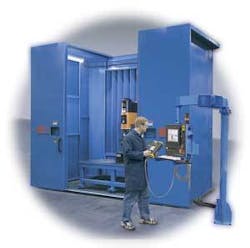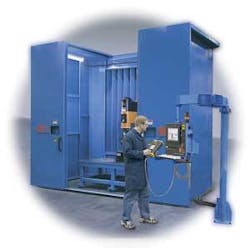Hole drilling in India
Bangalore, India-Hindustan Aeronautics Limited (HAL; www.hal-india.com/aerospacedivision.asp) has ordered what reportedly will be the first Nd:YAG laser in India to be used for laser processing turbine engine components. The system, a Laserdyne 790XS BeamDirector laser drilling system from Prima North America Inc. (Champlin, MN; www.prima-na.com), utilizes a Convergent Laser P50L high-peak power drilling laser.
HAL is a global provider of turbine engine components. The company has 16 production units and nine research and design centers in seven locations in India. With an impressive product track record for civilian and defense aircraft applications, its manufacturing success is based both on in-house research and development and licensing of its designs. In addition to aircraft, HAL manufactures turbine engines and has extensive overhaul capabilities for both aircraft and engines.
Mark Barry, vice president sales and marketing at Prima Laser Tools division, points out that although machine tools and technology in India typically have not met the standards available, for example, in North America or Europe, this purchase represents the most modern technology available in the world for producing laser drilled components. President and CEO of Prima North America Dr. Paolo Cigna comments on the order’s significance, saying, “It is the first order for a Laserdyne drilling system from India and, to our knowledge, the first Nd:YAG drilling system for aerospace applications in that country.” The system will enable workers at HAL to process parts both faster and to a more consistent airflow.
Laserdyne says its customers report airflow in turbine engine components is being held to a tolerance of +/-3 percent or better when using all the features of the company’s integrated systems, instead of +/-10 percent that was previously associated with laser drilling. The company adds that production rates are much greater than the older systems with tuned resonator Nd:YAG lasers.
The system is expected to be delivered to HAL sometime late during the first quarter of 2007.-LJB
Audi TT wins award
Ingolstadt, Germany-The winner of the coveted EuroCarBody Award presented by the Automotive Circle International is Audi, honored for the innovative body concept of its TT sports coupe. Audi was chosen over 13 competitors from around the world who submitted products for this award.
The body of the TT, introduced as a concept car in 1995 and brought to market in 1998, is the first Audi brand to employ the company’s groundbreaking Audi Space Frame (ASF) technology. It has an elaborate composition of aluminum and steel, with an extruded aluminum and die castings for the support structure and aluminum sheet panels.
Joining of the various parts is performed using punch-riveting, clinching, self-tapping screws, and bonding, but more importantly the TT employed laser welding technology to join the roof and side sections. This process used multiple Nd:YAG lasers with robot-manipulated fiber delivery, in what is thought to be the first production laser welding of aluminum body-in-white.
The 2008 version of the TT, shown in the photo, introduces high-strength steel into the material mix, further complimenting the ASF technology. On the Coupe version this makes the static torsional stiffness 50 percent higher than the original, and on the Roadster version the increase is 128 percent.
This is the second time that Audi has won the award, the first in 2003 for the A8 ASF body.-DAB
Nesting investment pays off
Jackson, WI-Engineered Metal Products (EMP) provides short-run sheet metal fabrication and prototyping services. In 2002 it purchased an Amada Gemini laser. Unfortunately, the CAM system EMP was using had a number of problems. According to Mike Fischer, laser operations manager, “We could never use the nesting module as it caused more problems than it solved, so all nests were produced manually. There was no auto-fixing of problem CAD files. The auto-sequencing did not work properly, costing us an average of 10 minutes per part to manually sequence. Other bugs in the system forced us to find manual workarounds, taking more time.”
To address these issues EMP embarked on an evaluation of five CAM systems, with nesting efficiency being the main driver. Fischer produced a nest of parts using his old system and used this to gauge performance of the evaluated systems. He found that JETCAM Expert (JETCAM International; www.jetcam.com) was the most efficient nester-saving up to 20 percent (half a sheet of material) on the test nest when compared with the other systems being benchmarked. ERP purchased a single license of the software along with the MRP module and the free-form high-performance nesting module.
The company has realized a significant improvement in programming capacity. Before the software purchase, a 5-6 sheet nest could take upwards of 10 hours to create and optimize. The new software now automatically tools, nests, and generates NC codes for the same parts in minutes-easily a 90+ percent improvement, according to EMP.
One additional benefit of the software that EMP did not anticipate was a drastic reduction in machining time. “I was surprised to see that the capacity of the laser increased. With more efficient NC code, coupled with less sheet handling on the laser we are seeing a 20-30 percent increase in machine capacity,” reports Fischer. “Nest efficiency also improved,” he says, “often by up to 30 percent.”
EMP is considering the purchase of an additional laser, but this decision only became possible once the issue of programming was resolved. Fischer concludes, “By all indications, the system is going to pay for itself in less than six months of purchase. With the old CAM system there was no way we could buy another machine without doubling our programming staff. Now we can increase capacity using the existing staff without a problem. We also have a clear upgrade path to full automation.”
Fighting against retail crime
Nottingham, England-Laser technology is being used by The Courtenay Group Ltd. in a new anti-theft solution that uses a high-performance laser to etch unique identification data directly onto products. The company’s Vendormark solution was recently piloted by pharmaceutical giants Boots, and proved extremely successful with that company reporting significant reduction in theft and the arrest of a market trader handling marked products along with the seizure of goods on sale on his stall.
As a result of the trial, Boots has purchased two Vendormark 6000 laser systems and several other leading retailers are currently testing this solution. This system uses a Domino S200W scribing laser to permanently imprint information on the precise outlet where the product is to be sold.
During the Boots trial, a laser was installed at its headquarters during which several high-profile cosmetic brands were security coded. The products were then shipped to Boots stores in the north and southeast of England. Shortly after the merchandise was placed in the stores, a quantity of stolen goods were identified from its unique Vendormark branding and reported to theftline, the Vendormark theft reporting services.
Courtenay Group chose Domino as their laser supplier in the development of this solution because of its global reputation as an expert in the coding and marking field, and their quality technology.
Vendormark raises public awareness of the offense of handling stolen goods, which, in the U.K., can result in jail sentences of up to 15 years.



